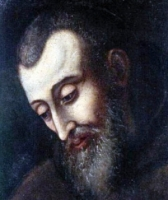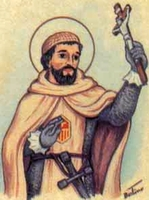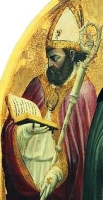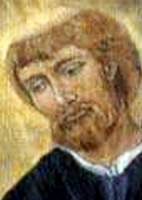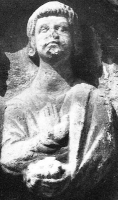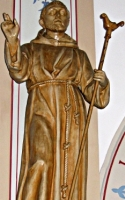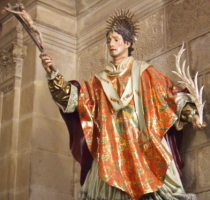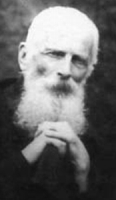Saint James the Lesser
புனிதர் யாக்கோபு (அல்பேயுவின் மகன்)
(St. James, Son of Alphaeus)
திருத்தூதர்:
(Apostle)
பிறப்பு: கி.மு. முதல் நூற்றாண்டு
கலிலேயா, யூதேயா, ரோம பேரரசு
(Galilee, Judaea, Roman Empire)
இறப்பு: கி.பி. 62
எருசலேம், யூதேயா, ரோம பேரரசு அல்லது எகிப்து
(Jerusalem, Judaea, Roman Empire or Aegyptus (Egypt)
ஏற்கும் சமயம்:
கத்தோலிக்க திருச்சபை
(Roman Catholic Church)
ஆங்கிலிக்கன் ஒன்றியம்
(Anglican Communion)
கிழக்கு மரபுவழி திருச்சபை
(Eastern Orthodox Church)
திருவிழா:
மே 3 (கத்தோலிக்கம்)
1 மே (ஆங்கிலிக்க ஒன்றியம்)
9 அக்டோபர் (கிழக்கு மரபுவழி திருச்சபை)
பாதுகாவல்:
மருந்தகப் பணியாளர்; இறக்கும் நிலையில் இருப்போர்; இத்தாலி, கம்பளி நெய்பவர்; தொப்பி செய்பவர்கள்; உருகுவை
அல்பேயுவின் மகனான புனித யாக்கோபு என்பவர் இயேசு கிறிஸ்துவின் பன்னிரு திருத்தூதர்களுள் ஒருவர். இவர் அல்பேயுவின் மகன் யாக்கோபு என்றே அனைத்து ஒத்தமை நற்செய்தி நூல்களிலும் உள்ள திருத்தூதர்களின் பட்டியலில் அழைக்கப்படுகின்றார்.
விவிலியத்தில்:
இவரைப்பற்றி விவிலியத்தில் அதிகம் இடம் பெறவில்லை. இவர் புதிய ஏற்பாட்டில் நான்கு முறை மட்டுமே குறிக்கப்படுகின்றார். செபதேயுவின் மகன் யாக்கோபுவிடமிருந்து பிரித்துக்காட்ட இவர் சிரிய யாக்கோபு அல்லது சின்ன யாக்கோபு என்று அழைக்கப்படுகின்றார். (மாற்கு 15:40) இப்பெயரே இவருக்கு பாரம்பரிய சுவடிகளிலும் உள்ளது.
மாற்கு நற்செய்தியில்:
அல்பேயுவின் மகன் யாக்கோபின் அழைப்பு :
மாற்கு நற்செய்தியாளரே முதன் முதலில் இவரை அல்பேயுவின் மகன் என திருத்தூதர்களைப் பட்டியல் இடும் போது அழைக்கின்றார். அவரும் ஒரே முறை தான் அழைக்கின்றார்.
மாற்கு நற்செய்தியில் இவர் அல்பேயுவின் மகன் லேவியின் அழைப்பு இடம் பெறுகின்றது. ஆயினும், லேவி திருத்தூதர்களின் பட்டியலில் இடம் பெறவில்லை. அவருக்கு பதில் அல்பேயுவின் மகன் யாக்கோபு இடம் பெறுகின்றார்.
மாற்கு நற்செய்தியில் பிற யாக்கோபு:
மாற்கு நற்செய்தியாளர் மூன்று யாக்கோபுகளை விகுதியுடன் குறிப்பிடுகின்றார். அவர்கள், அல்பேயுவின் மகன் யாக்கோபு, செபதேயுவின் மகன் யாக்கோபு, இயேசுவின் சகோதரரான யாக்கோபு. பிற மூன்று இடங்களில் விகுதியற்று குறிக்கின்றார். அவர்கள் உறுமாற்றத்தின் போது ஒலிவ மலையில் உள்ள யாக்கோபு, கெத்சமணி தோட்டத்தில் இயேசுவோடு இருக்கும் யாக்கோபு, தொலையில் நின்று இயேசுவின் சிலுவையை உற்று நோக்கிக்கொண்டிருந்தவர்களுல் ஒருவரான மரியாவைக்குறிக்க சின்ன யாக்கோபு, யோசே ஆகியோரின் தாயாகிய மரியா என்னும் போதும்.
மத்தேயு நற்செய்தியில்:
அல்பேயுவின் மகன் யாக்கோபின் அழைப்பு :
பேதுரு, அந்திரேயா, செபதேயுவின் மகன் யாக்கோபு மற்றும் அவரின் சகோதரர் யோவான் ஆகியோர் இயேசு கிறிஸ்துவின் சீடராக அழைக்கப் பெற்றனர். இதன் பின்னர் மாற்கு நற்செய்தியில் உள்ள அல்பேயுவின் மகன் லேவியின் அழைப்பைப் போன்றே மத்தேயு இயேசுவின் அழைப்பை பெறுகின்றார். ஆனாலும் மத்தேயு அல்பேயுவின் மகன் என குறிக்கப்படவில்லை எனினும் மத்தேயுவும் லேவியைப்போல வரி தண்டினவராக குறிக்கப்படுகின்றார். மத்தேயு நற்செய்தியில் வரி தண்டினவரான மத்தோயுவும், அல்பேயுவின் மகன் யாக்கோபுவும் திருத்தூதர்கள் பட்டியலில் இடம் பெறுகின்றனர்.
மத்தேயு நற்செய்தியில் பிற யாக்கோபு:
மத்தேயு தனது நற்செய்தியில் யாக்கோபுவைக்குறிக்கும் போது, அவரின் உறவுவினர்களை வைத்தே பிரித்துக் காட்டுகின்றார். மத்தேயு மூன்று யாக்கோபுகளை தன் நற்செய்தியில் குறிப்பிடுகின்றார். அவர்கள்
♫ யாக்கோபு, யோசேப்பு, சீமோன், யூதா ஆகியோர் இவருடைய சகோதரராக
♫ செபதேயுவின் மகனாகவும், யோவான் சகோதரராகவும்
♫ அல்பேயுவின் மகனாகவும்.
உறுமாற்றத்தின் போது இருந்த யாக்கோபு யோவான் சகோதரர் என குறிப்பிடப்படுகின்றார். கெத்சமணி தோட்டத்தில் இருந்தவர் அல்பேயுவின் மகனாக குறிப்பிடப்படுகின்றார். மேலும் தொலையில் நின்று இயேசுவின் சிலுவையை உற்று நோக்கிக்கொண்டிருந்தவர்களுல் ஒருவரான மரியாளைக்குறிக்க யாக்கோபு, யோசே ஆகியோரின் தாயாகிய மரியாள் என்னும் போதும் யாக்கோபுவுக்கு இவர் மாற்கை போல "சின்ன" என்னும் அடை மொழி இல்லாமல் குறிக்கின்றார்.
பாரம்பரியம்:
புனித யாக்கோபு என்னும் பெயருடன் ஒருவர் சில கிறிஸ்தவர்களோடு சேர்த்து கைது செய்யப்பட்டு, பின்னர் ஏரோது மன்னனால் தலை துண்டிக்கப்பட்டு கொலை செய்யப்பட்டார் என திருத்தூதர் பணிகள் நூல் குறிக்கின்றது. ஆனால் அது இவர் அல்ல எனவும், அது செபதேயுவின் மகன் யாக்கோபுவே எனவும் அறிஞர்கள் கொள்கின்றனர்.
இவர் பாரம்பரியப்படி எகிப்தில் மறைப்பணி ஆற்றும்போது சிலுவையில் அறையுண்டு கொல்லப்பட்டார் என்பது மரபு.
Also known as
• Jacobus Minor
• James the Just
• James the Less
• James the Younger
• James, son of Alphaeus
• James, the brother of the Lord
Additional Memorials
• 1 May (under the title James, son of Alpheus; Anglican)
• 9 October (Orthodox as James, son of Alpheus)
• 23 October (Luther Church in America as James the Just; Orthodox as James the Righeous)
• 26 December (Eastern Orthodox)
Profile
Cousin of Jesus. Brother of Saint Jude Thaddeus. Raised is a Jewish home of the time with all the training in Scripture and Law that was part of that life. Convert. One of the Twelve Apostles. One of the first to have visions of the risen Christ. First Bishop of Jerusalem. Met with Saint Paul the Apostle to work out Paul's plans for evangelization. Supported the position that Gentile converts did not have to obey all Jewish religious law, though he continued to observe it himself as part of his heritage, may have been a vegetarian. A just and apostolic man known for his prayer life and devotion to the poor. Martyr.
Having been beaten to death, a club almost immediately became his symbol. This led to his patronage of fullers and pharmacists, both of whom use clubs in their professions. He is reported to have spent so much time in prayer that his knees thickened, and looked like a camel's. Soon after the Crucifixion, James said he would fast until Christ returned; the resurrected Jesus appeared to him, and fixed a meal for James Himself.
Died
c.62 at Jerusalem by being thrown from a pinnacle of the Temple, then stoned and beaten with clubs, including fuller's mallets, while praying for his attackers
Patronage
• dying people
• apothecaries, druggists, pharmacists
• fullers
• hatmakers, hatters, milliners
• Uruguay
• 8 cities in Italy
Saint Philip the Apostle
புனிதர் பிலிப்
(St. Philip)
திருத்தூதர் மற்றும் மறைசாட்சி:
(Apostle and Martyr)
பிறப்பு:
பெத்சாயிதா, கலிலேயா, ரோம பேரரசு
(Bethsaida, Galilee, Roman Empire)
இறப்பு: கி.பி. 80
ஹிராபோலிஸ், அனடோலியா, ரோம பேரரசு
(Hierapolis, Anatolia, Roman Empire)
ஏற்கும் சமயம்: எல்லா கிறிஸ்தவ பிரிவுகளும்
நினைவுத் திருவிழா:
3 மே - கத்தோலிக்கம்,
14 நவம்பர் - கிழக்கு மரபுவழி திருச்சபை
பாதுகாவல்: உருகுவை.
திருத்தூதரான புனிதர் பிலிப், இயேசுவின் பன்னிரு திருத்தூதர்களுள் ஒருவர். கிறிஸ்தவப் பாரம்பரியப்படி, இவரே கிரேக்கம், சிரியா முதலிய நாடுகளுக்கு கிறிஸ்தவத்தைக் கொண்டு சென்றவர்.
பிலிப் எழுதிய நற்செய்தி என்னும் நாக் அமாடி நூலகத்தில் உள்ள நூல் இவரால் எழுதப்பட்டது போல் தோன்றினாலும், அது அவ்வாறு அழைக்கப்படுவது திருத்தூதர்களுள் இவரின் பெயர் மட்டுமே அதில் குறிப்பிடப்பட்டிருப்பதாலேயே ஆகும்.
இவரின் விழாநாள் கத்தோலிக்க திருச்சபையில் நீதிமானான புனித யாக்கோபுவோடு (திருத்தூதர் யாக்கோபு அல்ல) சேர்ந்து மே 3ல் கொண்டாடப்படுகின்றது.
புதிய ஏற்பாட்டில்:
ஒத்தமை நற்செய்தி நூல்கள் இவரை இயேசுவின் சீடர் என்கிறது. இவரும் அந்திரேயா மற்றும் பேதுருவைப்போல பெத்சாயிதாவைச் சேர்ந்தவர்.
நத்தானியேல் என அழைக்கப்பட்ட திருத்தூதரான பர்த்தலமேயுவை இயேசுவிடம் அறிமுகப்படுத்தியவர் இவரே. ஐயாயிரம் மக்களுக்கு அப்பம் பலுகச்செய்து உணவளித்த புதுமைக்கு முன்பு, இயேசு இவரைச் சோதித்தார்.
இவருக்கு கிரேக்கம் தெரிந்திருந்ததால் கிரேக்கர்கள் சிலர் இயேசுவைக்காண வந்தபோது இவர் அவர்களை இயேசுவிடம் கூட்டிவந்தார். இயேசுவின் இறுதி இரா உணவின் போது, "தந்தையை எங்களுக்கு காட்டும்" என்று பிலிப்பு கேட்க, இயேசு தந்தைக்கும் மகனுக்கும் உள்ள உறவு பற்றி விளக்கினார்.
புனித பிலிப்புவின் பெயர் எல்லாத் திருத்தூதர்களின் பட்டியல்களிலும் ஐந்தாவதாக பட்டியலிடப்பட்டுள்ளது.
புனித பிலிப்பு, யோவான் நற்செய்தியாளரால் மீண்டும் மீண்டும் குறிப்பிடப்படுகின்றார். இறைமகன் இயேசு, பேதுருவையும், அந்திரேயாவையும் தேர்ந்து கொண்டபிறகு, என்னைப் பின்பற்றி வா என்று கூறி பிலிப்பைத் தேர்ந்துகொண்டார். பிலிப்பும் இயேசுவின் அழைத்தலை ஏற்று உடனே அவரைப் பின் தொடர்ந்தார். இதிலிருந்து பிலிப்பு எந்த அளவிற்கு இயேசுவுக்கு பணிந்திருந்தார் என்பதை தெரிந்து கொள்ளலாம். பின்பு பிலிப்பு உடனே தன் நண்பர் நத்தனியேலிடம் சென்று, நடந்ததை எல்லாம் விளக்கினார்.
நாசரேத்திலிருந்து நல்லது எதுவும் வரக்கூடுமோ என்ற நத்தனியேலிடம் வந்து பாரும் என்று கூறி பதிலளித்தார் பிலிப்பு. இதிலிருந்து பிலிப்பு எவ்வளவு திறந்த மனதுடன் இருந்திருக்கிறார் என்பதை அறிந்து கொள்ளலாம். 200 தெனாரியத்திற்கு அப்பம் வாங்கினாலும் கூட போதாதே என்று யேசுவிடம் பதிலளித்தார் பிலிப்பு (யோவான் 6:7)
தூய ஆவியாரின் வருகைக்கு பிறகு பிலிப்பு ஆசியா சென்று மறைபரப்புப் பணியில் நாட்களை செலவிட்டார் என்று தியோடற், யுசிபியுஸ் என்ற பழங்காலத்து வரலாற்று ஆசிரியர்கள் குறிப்பிடுகின்றார்கள்.
Additional Memorials
• 3 May (Roman calendar; Evangelical Church in Germany)
• 1 May (Anglican; Evangelical Lutheran; Lutheran Church Missouri Synod; pre-1955 Roman calendar)
• 11 October (Lutheran; Episcopal Church USA)
• 14 November (Greek calendar; Orthodox; Russia)
• 17 November (Armenian Church)
• 18 November (Coptic Church)
• 31 July (translation of relics of Cyprus)
Profile
Disciple of Saint John the Baptist. Convert. One of the Twelve Apostle. Brought Saint Nathanael to Christ. Confidant of Jesus. Little is known about him, but scriptural episodes give the impression of a shy, naive, but practical individual. Preached in Greece and Asia Minor. Martyr.
Born
at Bethsaida, Palestine
Died
stoned to death while tied to a cross c.80 at Hierapolis, Phrygia (near modern Pamukkale, Turkey)
Patronage
• hat makers, hatters, milliners
• pastry chefs
• Luxembourg
• Uruguay
• 37 cities
Saint Ansfrid of Utrecht
Also known as
Ansfridus, Ansfried, Ansfrido
Profile
Count of Brabant. Married to Hilsondis; father of one daughter; after the girl's birth, Ansfrid and Hilsondis, lived as brother and sister. Courtier and knight in the service of Holy Roman Emperor Otto III and Saint Henry II. After many years of this life he realized a call to religious life, and in 974 he gave up his life as a soldier. In 992 he founded a convent at Thorn, Netherlands, which his wife and daughter entered; his daughter eventually became abbess. He founded a Benedictine monastery at Heiligenberg, Germany, and planned to enter it as a monk, but in 994, in the face of local opposition, he was named bishop of Utrecht, Netherlands by Otto. Late in life his eyesight began to fail, and by 1006 he was blind; though he kept the title of bishop, he was finally able to retire to the Heiligenberg abbey where he spent his remaining days as a prayerful monk. There is a single church dedicated to Saint Ansfrid; it is located in Amersfoort, Netherlands.
Born
c.940 in the Brabant region
Died
3 May 1010 in Amersfoort, Netherlands of natural causes
Blessed Emilia Bicchieri
Profile
Four of seven daughters born to the wealthy Ghibelline patrician family of Pietro Bicchieri. Emilia was well educated, and early on showed a she was drawn to religious life, withdrawing to her room for hours of prayer. Her mother died when Emilia was still a girl, and her father became even more protective, and initially objected to Emilia becoming a nun. He eventually realized her true calling, and funded the construction of the Dominican monastery of Santa Margherita in Vercelli, Italy. Emilia entered the abbey as a Dominican nun at age 18. She was repeatedly chosen to serve as prioress of the house, but repeatedly refused and concentrated on menial domestic service to her sisters. She finally became prioress in 1273. She always had, and always promoted, devotion to the Eurcharist, the Passion, and Blessed Virgin Mary.
Born
1238 in Vercelli, Piedmont, Italy
Died
• 3 May 1314 in Vercelli, Piedmont, Italy
• interred at the Santa Marghertia abbey in Vercelli
• relics enshrined in the cathedral of Vercelli
Beatified
19 July 1769 by Pope Clement XIV (cultus confirmation)
Saint Stanislas Kazimierczyk
Also known as
• Louis Scholtis
• Louis Soltys
• Stanislas Kazimierz
• Stanislaw Kazimierczyk
Profile
Raised in a pious family, the son of Maciej and Jadwiga Soltys, he received a good education in the faith. Received doctorates in theology and philosophy from Jagiello University, Kraków, Poland. Entered the Canons Regular of the Lateran in 1456, devoting his life to the Eucharist and to the care of the sick and the poor, and taking the name Stanislas Kazimierczyk. Priest, noted as a great preacher and popular confessor. Prior and novice master at his monastery. Professor of philosophy and theology. Friend of Saint John of Kanty. Like many holy people, the people who knew him considered him a living saint while Father Stanislas saw his own life as a constant struggle for holiness.
Born
27 September 1433 in Kazimierz, Lubelskie, Poland as Louis Soltys
Died
• 3 May 1489 in Kazimierz, Lubelskie, Poland of natural causes
• interred in the church of Corpus Domini, Kazimierz
Canonized
17 October 2010 by Pope Benedict XVI
Blessed Tommaso Acerbis
Also known as
• Tommaso of Olera
• Thomas of...
Profile
Born to a poor family, the boy worked as a shepherd in his youth and received no schooling at all. Joined the Capuchin Friars Minor on 12 September 1580 at Verona, Italy where at age 17 he finally learned to read and write. Tommaso made his final profession on 5 July 1584 and served as a clerk in convents in Verona, Vicenza, and Rovereto until 1617. Outside the convent he visited the sick, helped the poor, and encouraged a love of the faith to anyone who would listen. When Lutheranism began to make inroads in the area, Tommaso spoke and wrote in defense of the Church; he didn't confront, he didn't preach blood and thunder, he simply spoke on his love 'the impassioned Christ' and the Church he founded - and it was persuasive.
Born
1563 in Olera, Bergamo, Italy
Died
• 3 May 1631 in Innsbruck, Tyrol, Austria of natural causes
• buried in the crypt of the chapel of Our Lady at the local Capuchin church in Innsbruck
Beatified
21 September 2013 by Pope Francis
Saint Gabriel Gowdel
Additional Memorial
22 September (translation of relics)
Profile
Son of Peter and Anastasia Gowdel who were pious Orthodox Christians. Gabriel was noted for his piety and prayer from a very early age. He was a murder victim, and was considered a martyr. His attacker buried the body in a wooded area near the village where stray dogs guarded it until it was discovered by the villagers nine days after the crime; the body was incorrupt.
During an epidemic in 1720, children were buried near him, their families considering the ground around a martyr to be especially hallowed. His body was accidentally exhumed, and found to be incorrupt. There were many miraculous cures after the incident, and the end of the epidemic followed soon after.
Born
22 March 1684 at Zwierki, Poland
Died
• murdered on 11 April 1690
• body transferred to the church at Zwierki, Poland
• the church burned in 1746 - Gabriel's hand was burned, but healed
• relics translated to Saint Nicola's Cathedral, Bialystok in 1922
Patronage
children
Saint Conleth of Kildare
Also known as
Concletus, Conlaed, Conlaeth, Conlaid, Conlaith, Conlath, Conleat, Conleath, Conlethus, Conlian, Conleto
Profile
Skilled worker in gold and silver, and manuscript illuminator. Hermit in a cell in Old Connell, Ireland near the Liffey river. His reputation for holiness attracted would-be disciples. Friend of and co-worker with Saint Brigid; they ran first double monastery together. First bishop of Kildare, Ireland c.490. Baptised Saint Tigernach of Clogher. Died while on pilgrimage to Rome, Italy.
Born
c.450 in Ireland
Died
• attacked by wolves on 3 May 519 in the forests of Leinster, Ireland
• buried nearby
• relics translated to the Kildare cathedral in 799
• relics taken to Connell in 835 to protect them from Danish invaders
Patronage
Kildare, Ireland, diocese of
Pope Saint Alexander I
Also known as
Alessandro I
Profile
Roman citizen. Pope in the reign of Emperor Trajan. Baptized Saint Balbina of Rome. He inserted in the Canon of the Mass the words commemorative of the institution of the Eucharist beginning "Qui pridie". Introduced the use of blessing water mixed with salt for the purification of Christian homes from evil influences. Martyr. While in prison awaiting execution, he converted the criminals who became the Martyrs of Ostia.
Born
probably Rome, Italy
Papal Ascension
between 106 and 109 (sources vary)
Died
• burned and beheaded 3 May between 113 and 119 (sources vary on the year) on the Via Nomentana in Rome, Italy
• relics transferred to Freising in Bavaria in 834
Blessed Arnaldo de Rossinol
Profile
Orphaned young, Arnaldo was raised by his uncle, the archbishop of Tarragona, Spain. As a young man, Arnaldo served briefly in the court of King Peter III but felt a call to religious life, and became a lay knight in the Mercedarians. His dedication and personal piety were so obvious to his superiors that they sent him to rescue Christians enslaved by Muslims in Andalusia, Spain, and then in Tunis, North Africa where he served as a captive in exchange for some slaves. Commander of the Mercedarian convent in Lérida, Spain. Chosen Master General of the Mercedarians on 12 November 1308, a position in which he served the rest of his life.
Born
latter 13th century Spain
Died
3 May 1317 at the convent of Santa Maria degli Angeli in El Puig, Valencia, Spain of natural causes
Blessed Guglielmo of Florence
Also known as
• Guglielmo da Firenze
• Guglielmo Novelli
• Guglielmo Fiorentino
• William...
Profile
Born to the nobility, the family of the counts of Gueda. Mercedarian friar. Served as the Master General of the Mercedarians. He helped broker peace between forces loyal to the Guelphs and Ghibellines, and was so successful that Pope Alexander IV granted privileges to the Order in gratitude. Guglielmo was the friar who found Blessed Peter Armengol hanged in a tree and being saved by the Blessed Virgin Mary. Assigned to redeem Christians enslaved by Muslims in north Africa, he was imprisoned and, when he refused to renounce his faith, murdered. Martyr.
Born
Florence, Italy
Died
crucified in 1330 in Algiers, Algeria
Blessed Marie Leonie Paradis
Also known as
Alodie-Virginie Paradis
Profile
Born to a poor but pious family. Educated by the Sisters of Notre Dame. Joined the Marianite Sisters of the Congregation of the Holy Cross on 21 February 1854, taking her final vows in 1857. Taught in Montreal, in New York, and in Indiana. With 14 of her sisters, she founded the Poor Sisters of the Holy Family, devoted to assisting priests and seminarians, at Memramcook, New Brunswick in 1877.
Born
12 May 1840 in L'Acadie, Quebec, Canada as Alodie-Virginie Paradis
Died
3 May 1912 in Sherbrooke, Quebec, Canada
Beatified
11 September 1984 by Pope John Paul II at Montreal, Canada
Patronage
archdiocese of Sherbrooke, Canada
Saint Juvenal of Narni
Also known as
Giovenale, Juvenalis
Profile
Ordained by Pope Saint Damasus I. First bishop of Narni, Italy in 368. Legend says that he saved Narni from invasion by Ligurians and Sarmatians praying for a great thunderstorm so great that the invaders fled in fear. Another story says that there was an attempt on his life by trying to strike him in the head with a sword; Juvenal caught the blade in his teeth and the would-be killer gave up.
Died
• c.373
• may have been a martyr, but records are unclear
Patronage
• city of Narni, Italy
• diocese of Terni-Narni-Amelia, Italy
Saint Maura of Antinoe
Also known as
Moura
Profile
Lay woman. Married to Saint Timothy of Antinoe. About twenty days into the marriage, and in the middle of the persecution of Diocletian, Timothy was arrested. As he was being tortured to learn the location of sacred texts, Maura was dragged to the prison; the authorities thought that if they threatened to torture her, Timothy would break. Timothy refused to talk, and Maura made a profession of her faith. Enraged at their defiance, Arrianos, governor of Thebias, ordered her tortured. Witnesses begged that the tormentors release the innocent woman, but she told them that God was all the protection she needed. Martyred with Saint Timothy.
Died
• c.286
• nailed to a wall in mock crucifixion, it took her nine days to die of shock, blood loss, and dehydration
Saint Timothy of Antinoe
Profile
Layman son of a priest named Pikolpossos. Lector and copyist, he was responsible for the security of the liturgical texts used in services. Married to Saint Maura of Antinoe. About twenty days into the marriage, and in the middle of the persecution of Diocletian, Timothy was arrested. Dragged before Arrianos, governor of Thebias, he was ordered to surrender any Scripture writings he had hidden; he refused. Horribly tortured, including being burned, hung upside down, and having his eyelids cut off; he still refused. Martyred with Maura.
Born
Perapa (Egyptian Thebaid)
Died
nailed to a wall in mock crucifixion c.286 in Thebais, Egypt; it took him nine days to die of shock, blood loss, and dehydration
Blessed Ramon Oromí Sullà
Profile
Priest. Member of the Sons of the Holy Family; worked as secretary for his Institute. Publisher of their magazine. Wrote the first biography of Saint Josep Manyanet-y-Vives. Catechist and spiritual director for young people, working closely with those with a call to religious life. Promoted devotion to the Holy Family as a way for families to stay together. Arrested on 19 April 1937 by anti-Church forces. One of the Martyrs of the Spanish Civil War.
Born
16 September 1875 in Salàs de Pallars, Lleida, Spain
Died
• 3 May 1937 in Montcada, Barcelona, Spain
• body thrown into a common grave
Beatified
13 October 2013 by Pope Francis
Blessed Edoardo Giuseppe Rosaz
Also known as
• Edward Joseph Rosaz
• Edvard Josef Rosaz
Profile
Ordained in 1854 at Nice, France. Worked in prison ministry. Wrote a catechism. Founded a home for abused and abandoned children in 1856. Founded the Sisters of the Third Order of Saint Francis of Susa. Bishop of Susa, Italy on 24 February 1878.
Born
15 February 1830 in Susa, Piedmont, Italy
Died
3 May 1903 in Susa, Piedmont, Italy
Beatified
14 July 1991 by Pope John Paul II in Susa, Piedmont, Italy
Saint Ahmed the Calligrapher
Profile
Raised as a Muslim in 17th-century Constantinople. Calligrapher and copyist in the royal chancery. He lived as an unmarried layman, but had a concubine, a Christian slave woman from Russia. Little by little, she brought him to a desire for the faith, and he began his catechumenate. However, before he could be baptized he was betrayed by another calligrapher who spotted him with Christian. Ahmed was arrested, imprisoned without food for a week, and then murdered for his desire to convert. Martyr.
Died
beheaded in 1682
Saint Aldwine of Peartney
Also known as
• Aldwyn of Peartney
• Ealdwine of Peartney
• AElwinus of Peartney
Profile
Raised in a pious family; his brother Ethelwine was the second bishop of Lindsey, England, and his sister Ethelhild was abbess in Lincolnshire, England. Founded the monastery Athelney in Somerset, England. Monk. Abbot of Peartney in Lincolnshire, England.
Born
7th century England
Died
early 8th-century at Peartney Abbey, Lincolnshire, England of natural causes
Blessed Adam of Cantalupo in Sabina
Also known as
Adamo
Profile
11th century monk and hermit who rebuilt churches in Cantalupo in Sabina, Italy that had been destroyed by invading Saracens. Miracle worker.
Beatified
1634 by Pope Urban VIII
Blessed Zechariah
Also known as
Zaccaria
Profile
Franciscan, accepted into the Order in Rome, Italy by Saint Francis of Assisi. Sent to Spain by Saint Francis to preach Christianity to the Moors. Used miracles to prove the Real Presence.
Died
• c.1249
• buried in the floor of the main chapel of the monastery of Saint Catherine of Alemquer, Portugal
• relics enshrined in a grated wall creche of the chapel c.1562
Saint Alexander of Constantinople
Profile
Soldier in the imperial Roman army. In the persecutions of Maximian, he changed clothes and places with Saint Antonina of Constantinople after she had been condemned to live as a prostitute. They were discovered, tortured, their hands cut off, and killed. Martyr.
Died
burned alive in 313 in Constantinople
Saint Antonina of Constantinople
Profile
Consecrated virgin. In the persecutions of Maximian, she changed clothes and places with Saint Alexander of Constantinople after she had been condemned to live as a prostitute. They were discovered, tortured, their hands cut off, and killed. Martyr.
Died
burned alive in 313 in Constantinople
Saint Ethelwin of Lindsey
Profile
Eighth century monk at Ripon Abbey. Hermit on Farne Island for 12 years. Friend of Saint Egbert. Bishop of Lindsey, England. Late in life he retired to religious life in Ireland.
Died
• 8th century Ireland of natural causes
• buried at Lindisfarne, England
Saint Alexander of Rome
Profile
Priest in Rome, Italy. Imprisoned, tortured and martyred with Saint Theodulus of Rome and Saint Eventius of Rome.
Died
• burned and beheaded c.113 on the Via Nomentana in Rome, Italy
• relics interred in the Dominican church of Santa Sabina, Rome
Saint Theodulus of Rome
Profile
Priest in Rome, Italy. Imprisoned, tortured and martyred with Saint Alexander of Rome and Saint Eventius of Rome.
Died
• burned and beheaded c.113 on the Via Nomentana in Rome, Italy
• relics interred in the Dominican church of Santa Sabina, Rome
Saint Eventius of Rome
Profile
Priest in Rome, Italy. Imprisoned, tortured and martyred with Saint Theodulus of Rome and Saint Alexander of Rome.
Died
• burned and beheaded c.113 on the Via Nomentana in Rome, Italy
• relics interred in the Dominican church of Santa Sabina, Rome
Saint Philip of Zell
Profile
Anglo-Saxon pilgrim. Hermit near Worms, Germany. Friend of and advisor to King Pepin the Short. Founded the monastery of Zell, Germany around which grew the town of the same name.
Died
c.770 of natural causes
Patronage
babies
Blessed Alexander of Foigny
Profile
Born to a royal Scottish family; brother of Blessed Mechthild. Cistercian monk at Foigny monastery, diocese of Laon, France.
Born
c.1180 in Scotland
Died
4 May 1229 of natural causes
Saint Adalsindis of Bèze
Also known as
Adalsainde, Adalseinde, Adalsind
Profile
Sister of Saint Waldalenus. Abbess of a convent near Bèze under the supervision of her brother.
Died
c.680 of natural causes
Blessed Giovanni Avogadro of Vercelli
Profile
15th-century Augustinian canon noted for his piety and humility.
Born
mid-15th century Italy
Died
1497 of natural causes
Blessed Alexander Vincioli
Profile
Franciscan priest. Confessor to Pope John XXII. Bishop of Nocera, Umbria, Italy.
Born
in Perugia, Italy
Died
1363 at Sassoferrato, Italy
Saint Eusebius of Auxerre
Also known as
Eusebio
Profile
Priest. No other information has survived.
Died
relics enshrined in Auxerre, France
Saint Viola of Verona
Also known as
Iole, Violetta
Profile
Early martyr. No other information has survived.
Died
relics enshrined in Verona, Italy
Saint Avitus of Auxerre
Also known as
Avito
Profile
Deacon. No other information has survived.
Died
relics enshrined in Auxerre, France
Saint Scannal of Cell-Coleraine
Profile
Spiritual student in Ireland of Saint Columba of Iona. Zealous missionary.
Died
c.563
Saint Rhodopianus the Deacon
Profile
Deacon. Martyred in the persecutions of Diocletian.
Died
in Aphrodisia, Caria, Asia Minor
Saint Fumac
Also known as
Fumach
Profile
First Christian missionary in Banffshire, Scotland. A healing well there is named for him.
Patronage
Drummuir, Scotland
Saint Diodorus the Deacon
Profile
Deacon. Martyred in the persecutions of Diocletian.
Died
in Aphrodisia, Caria, Asia Minor
Saint Roincenn Conlaedh
Profile
Son of Ugaine Mor. Bishop in the area of Cill-dara, Ireland.
Born
Ireland
Died
519
Saint Peter of Argos
Profile
Bishop in Argos, Greece; known for his ministery to the poor and slaves, and as a peacemaker.
Died
c.922
Blessed Sostenaeus
Profile
I have no information on this saint's life.
Died
Mount Senario near Florence, Italy while at prayer
Blessed Uguccio
Profile
I have no information on this saint.
Died
Mount Senario near Florence, Italy while at prayer
Saint Daircheall of Gleann-da-locha
Profile
Early Irish bishop.
Saint Cairpre of Maghbile
Profile
Early Irish bishop.
Saint Nem of Drum Dallain
Profile
Early Irish bishop.
Saint Sarnat
Profile
Daughter of Maelan. Nun. Abbess.
Born
Irish
Saint Clothach
Profile
Early Irish bishop.






